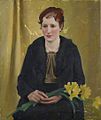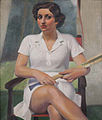Percy Shakespeare
Percy Shakespeare (born 28 February 1906 in Dudley, England;[1] died 25 May 1943 in Brighton, England[2]) was an English painter[1] who died in an air raid during the Second World War[1].
Percy Shakespeare | |
|---|---|
.jpg) Detail from Self Portrait - Morning Exercise | |
| Born | 28 February 1906 |
| Died | 25 May 1943 (aged 37) |
| Cause of death | Bombardment |
| Education | Dudley Art School |
| Alma mater | Birmingham School of Art |
| Occupation | Painter |
Life
Shakespeare was born in 1906 in the working class area of Kates Hill, Dudley, the fourth of eight children[1] of John Thomas Shakespeare and his wife Ada.[2] His family subsequently moved to council housing in the nearby Wren's Nest Estate area.[1] In 1920, after a chance meeting at the Dudley Museum and Art Gallery with Ivo Shaw, the principal of Dudley Art School,[1] he was offered a place at the school where his fees were waived for his eight years attendance[1] where he showed a talent for figure drawing and portraits. Eventually he attended Birmingham School of Art, where he studied anatomical drawing under Harold Holden[1] from 1923 to 1927[1] and obtained an Art Masters Certificate in Anatomical Drawing,[1] and qualified as a teacher. He taught part-time, mostly at Birmingham Art School and occasionally at Kidderminster College.[1]
For the rest of his life he continued to paint with a view to making that his career and produced a number of paintings each year (mainly in oil) that were submitted to the Royal Academy, and often accepted for exhibition. In 1933 he produced his most controversial painting, a self-portrait in which, it has been suggested, he is posing as the demonic figure Mephistopheles[3]. In the same year, he had his first exhibit at the Royal Academy, "A Mulatto", a portrait of a lady which was later bought by Dudley Art Gallery. He also exhibited at the Paris Salon and at the Royal Birmingham Society of Artists, of which he was elected an associate in 1936.[1] During this period, he was living in the family council house on the Wren’s Nest. Despite his success at having his paintings included in prestigious exhibitions, few of them sold and his only significant income was from his teaching. He had no studio and often painted in his small bedroom. [4]
When World War II broke out in 1939, he enlisted[1] in the Royal Navy, and trained at HMS Vernon[1] while continuing to paint in his spare time. In May 1943, whilst stationed ashore at Roedean School[1] in East Sussex, he was killed in a bombing raid while he was walking alone opposite Marine Gate in Brighton.[1].
Work
General
Shakespeare's work after leaving art school concentrated on figure drawings and portraiture, this continued until he started on his Thirties at Leisure series in 1936. His major works outside this series included the following:
- Portrait of Alan Young (1928)
- Gwendoline Shakespeare (c1929)
- Girl in Green Ball Gown (c1929)
- Self Portrait in pencil (c1930)
- Rasp Grinders (1932)
- View from Artists Bedroom /The Window (?1932)
- Miss Molly Betteridge (1932)
- The Rendezvous (1932)
- Isobel (1932)
- Seated Nude (1933)
- Mrs Neil Jenkins (1933)
- A Mulatto (1933)
- Self-portrait with Trilby (Mephistopheles) (1933)
- Morning Exercise (1934)
- On the Rhine (1935)
- White Gloves (1936)
- Boy and Dog (1937)
- Girl with Daffodils (1937)
- Tennis Player (c1938)
- Schoolgirl (1938)
_-_Percy_Shakespeare.jpg) Gwendoline Shakespeare, 1929
Gwendoline Shakespeare, 1929 View from the artist's bedroom, ?1932
View from the artist's bedroom, ?1932 A Mulatto, 1933
A Mulatto, 1933_-_Percy_Shakespeare.jpg) Self Portrait (Mephistopheles), 1933
Self Portrait (Mephistopheles), 1933 Mrs Neil Jenkins, 1933
Mrs Neil Jenkins, 1933_-_Percy_Shakespeare.jpg) Seated nude, 1933
Seated nude, 1933 Morning Exercise, 1934
Morning Exercise, 1934 On the Rhine,1935
On the Rhine,1935 Boy and Dog, 1937
Boy and Dog, 1937 Girl with Daffodils, 1937
Girl with Daffodils, 1937 The Tennis Player, c1938
The Tennis Player, c1938 Schoolgirl, 1938
Schoolgirl, 1938
The Thirties at Leisure series
From 1936, Shakespeare embarked on a series of oil paintings showing groups of people at leisure. These compositions were the result of intense work with many preliminary drawings of the component figures. It has been noted that the drawings themselves are of considerable merit in their own right. He painted one or two of these compositions each year and submitted them to the Royal Academy and often they were accepted. They are remarkable in their colour and figure arrangements and together they present a remarkable picture of leisure activities in the period leading up the Second World War.[4]
This series included the following works:
- The Bathing Party (1936)
- Tennis (1937)
- Afternoon at the Ice Rink (1938)
- Seaside photographer (c1938)
- Pavilion (at Dudley CC) (c1938)
- The Crooner (c 1938)
- The Team Race (c1938)
- The Boat Shed (1939)
- The Bird House (1939)
- The Broads (1940)
- Caravanners (1941)
There were two other paintings made in Sussex during Shakespeare's war service with a tenuous relationship to this series:
- December on the Downs (1942)
- The Ante Room HMS Vernon (1942)
 The Crooner, c 1938
The Crooner, c 1938 Afternoon at the Ice Rink, c1938
Afternoon at the Ice Rink, c1938 The Bird House, 1939
The Bird House, 1939 The Boat Shed, 1939
The Boat Shed, 1939 December on the Downs, 1942
December on the Downs, 1942
Legacy
In an obituary, Ivo Shaw was quoted as saying: "He was the best painter in oils the School had produced".[5]
Many of the paintings he left behind are held at Dudley Museum and Art Gallery. The Gallery mounted exhibitions of his work in 1979 and 1999 which featured both the paintings from their colection and others which were loaned from private owners.[1]
In 2009, his work was featured in an episode of BBC TV's Flog It!.[6]
External links
| Wikimedia Commons has media related to Percy Shakespeare. |
- Millington, Ruth (2 March 2018). "Percy Shakespeare: Dudley's dreamer?". Artist in focus.
- Shaw, S. (September 2018). "It's All Happening at the Zoo: Percy Shakespeare, Tropical Bird House, Dudley Zoo (c.1939)". Midlands Art Papers (2).
- Percy Shakespeare - A Dudley Artist. A short film about the life and works of the artist
- Percy Shakespeare: Dudley's Painter of the Thirties, by Robin Shaw. A monograph about the life and works of the artist, published 2000.
References
- Shaw, Robin (2000). Percy Shakespeare : Dudley's painter of the thirties. ISBN 0-9539126-0-4.
- CWGC Casualty Record, Brighton County Borough, civilian war dead.
- Richard, Warren (26 July 2011). "Percy Shakespeare and the hand of Satan".
- "Artist in focus: Percy Shakespeare". www.dudley.gov.uk.
- Shaw, Ivo (1 June 1943). "Obituary". Birmingham Post.
- "Dudley". Flog It!. Series 7. 11 March 2009. BBC. Retrieved 3 November 2012.